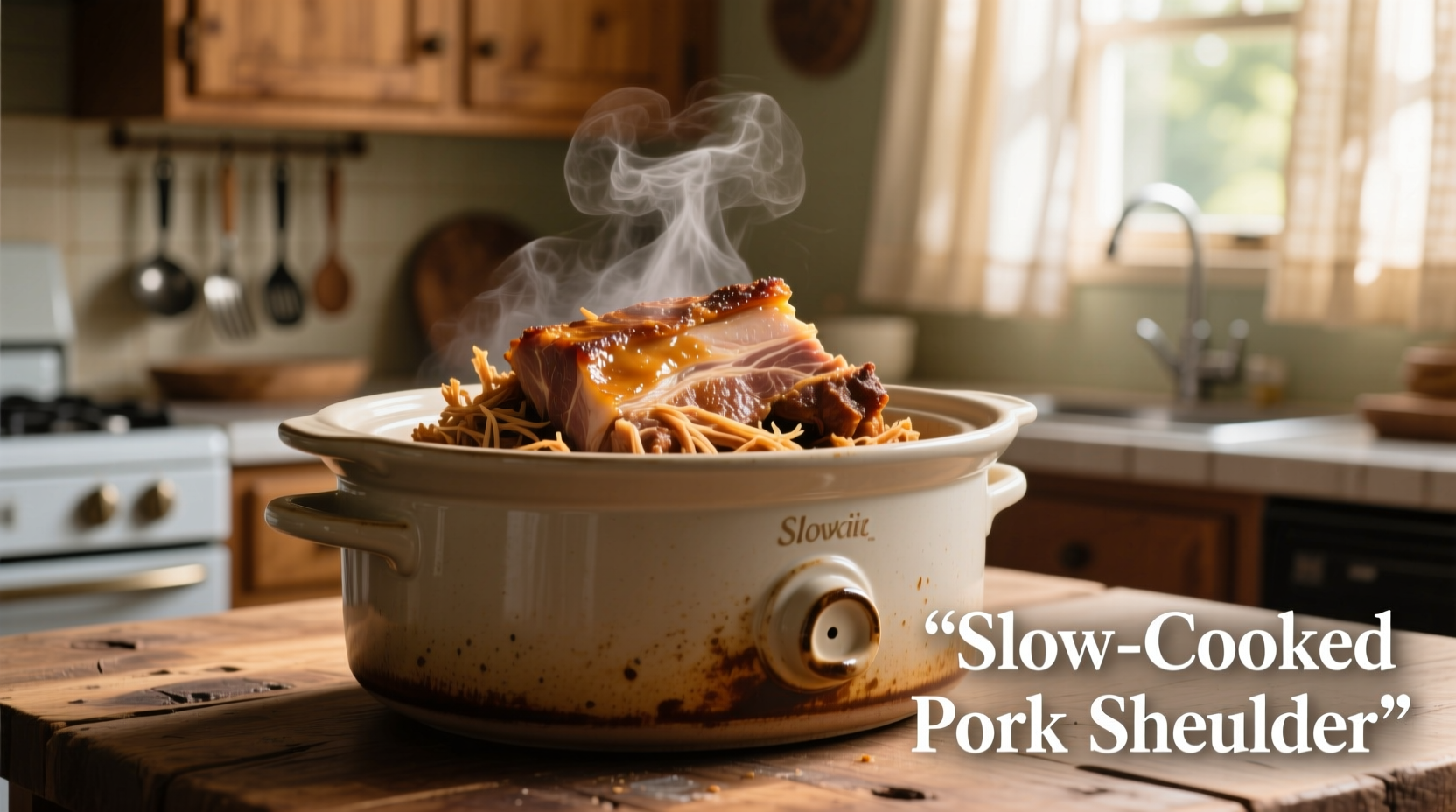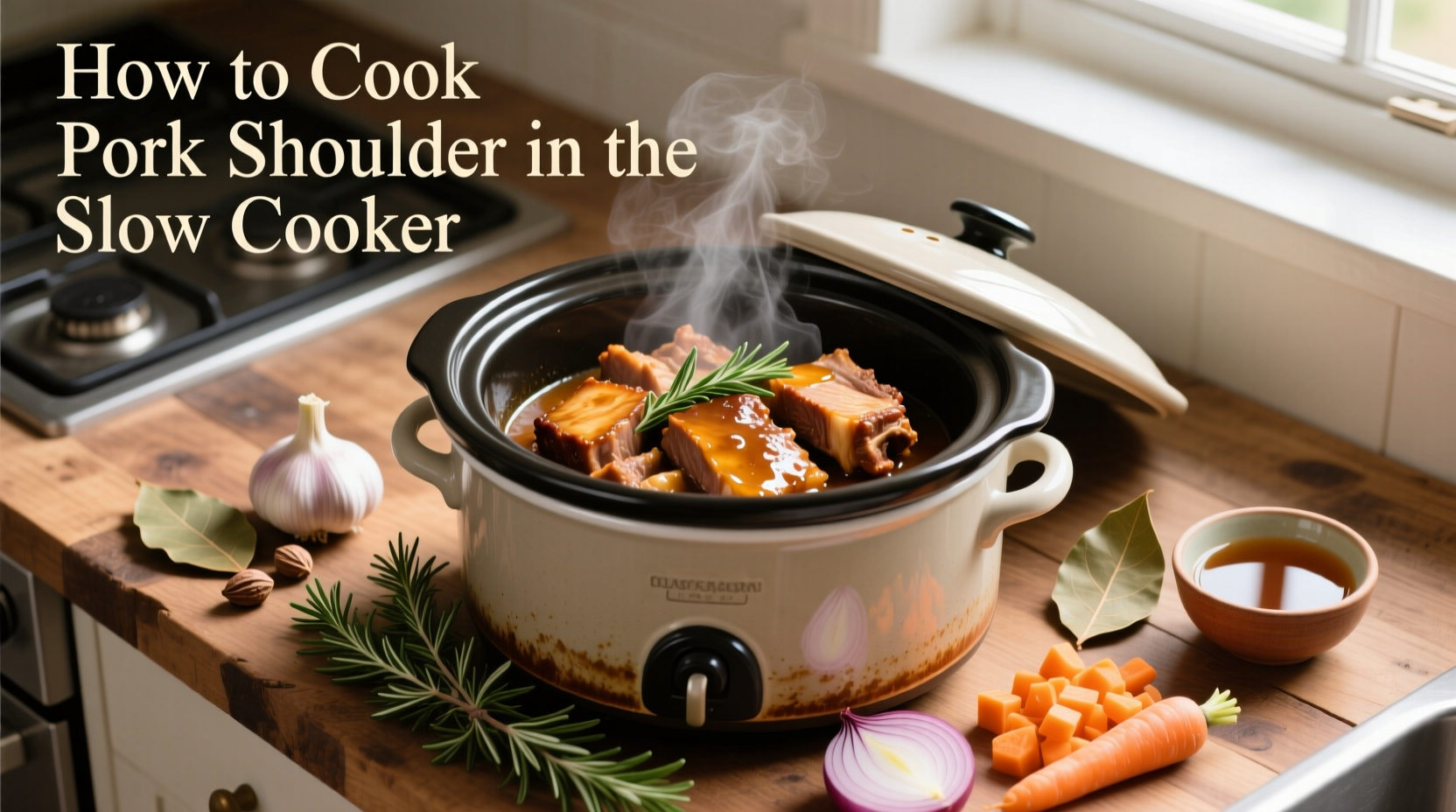Why Slow Cooking Transforms Pork Shoulder
Pork shoulder (also called pork butt or Boston butt) contains abundant connective tissue that requires low, slow heat to transform into melt-in-your-mouth tenderness. Unlike leaner cuts, this marbled cut thrives in the slow cooker where collagen breaks down gradually between 195-205°F. The USDA Food Safety and Inspection Service confirms that while 145°F is safe for standard pork, collagen-rich cuts require higher temperatures for optimal texture.

Shopping Guide: Selecting Your Pork Shoulder
Choose wisely for best results:
- Bone-in vs boneless: Bone-in (7-8 lbs) yields more flavor but requires 1-2 extra hours; boneless (4-5 lbs) cooks faster
- Fat cap: Look for 1/4-inch fat layer—essential for moisture retention during long cooking
- Color: Fresh pink hue with firm texture indicates quality; avoid grayish tones
- Weight: Allow 1/2 pound raw weight per serving (shrinks by 25-30%)
Step-by-Step Cooking Process
Follow this professional-tested sequence for guaranteed success:
Prep Phase (10 minutes)
- Pat meat dry with paper towels—critical for proper browning
- Trim excess fat to 1/4-inch thickness (save trimmings for rendering)
- Rub generously with 2 tbsp kosher salt, 1 tbsp black pepper, 2 tsp garlic powder
- Optional: Sear in hot oil 3-4 minutes per side for deeper flavor
Cooking Phase (8-10 hours on LOW)
| Meat Weight | LOW Setting | HIGH Setting | Required Liquid |
|---|---|---|---|
| 4-5 lbs (boneless) | 8-9 hours | 5-6 hours | 2 cups |
| 7-8 lbs (bone-in) | 9-10 hours | 6-7 hours | 3 cups |
| Per additional pound | +45 min | +30 min | +1/2 cup |
Place meat fat-side up in slow cooker. Add liquid (broth, apple cider, or water), 1 sliced onion, and 4 smashed garlic cloves. Cook uncovered on LOW—never HIGH for best texture. The National Center for Home Food Preservation confirms slow cookers maintain safe temperatures above 140°F when filled at least half full.
Doneness Check (Non-Negotiable)
Don't guess—verify with these indicators:
- Thermometer reading: 195-205°F in thickest part (collagen fully dissolved)
- Fork test: Two forks twist meat apart with zero resistance
- Texture: Shreds effortlessly without pulling fibers
Troubleshooting Common Issues
Fix problems before they ruin your meal:
"My pork is dry"
Cause: Insufficient liquid or overcooking. Solution: Return to cooker with 1/2 cup broth, cook 30-60 minutes more. Always measure liquid—never eyeball.
"Meat won't shred"
Cause: Undercooked collagen. Solution: Continue cooking in 30-minute increments until thermometer reads 200°F. Rushing this stage guarantees tough results.
"Excess fat layer"
After cooking, place meat in bowl, pour juices through strainer, chill 15 minutes. Solidified fat lifts off easily—this professional trick removes 95% of fat without losing flavor.
Serving & Storage Guide
Maximize your results with these pro tips:
- Resting: Let meat sit 15-20 minutes before shredding to redistribute juices
- Shredding: Use two forks or clean hands—discard any large fat chunks
- Serving: Mix with 1/2 cup reduced cooking liquid for perfect moisture
- Storage: Keeps 4 days refrigerated or 3 months frozen in liquid
Flavor Variations Worth Trying
Customize while maintaining cooking fundamentals:
- Carolina-style: Add 1 cup apple cider vinegar + 1/4 cup brown sugar
- Tex-Mex: Replace liquid with 2 cups salsa + 1 tbsp cumin
- Asian twist: Use coconut milk + ginger + 2 tbsp soy sauce
- Dietary swap: Replace sugar with monk fruit sweetener for keto version
Pro Tip: For crisper texture, spread shredded pork on baking sheet and broil 3-5 minutes before serving—this replicates authentic barbecue stand results at home.
When Slow Cooking Isn't Ideal
Consider these limitations before starting:
- Power interruptions: If power fails for >1 hour, discard meat per USDA guidelines
- Small batches: Under 3 lbs cooks unevenly—use oven method instead
- Immediate meals: Need dinner in <4 hours? Opt for pressure cooker method











 浙公网安备
33010002000092号
浙公网安备
33010002000092号 浙B2-20120091-4
浙B2-20120091-4